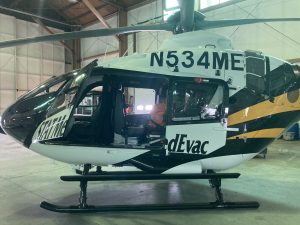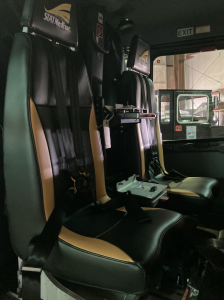
Currently, STAT MedEvac has eighteen helicopter base sites in operation daily. These locations include Pennsylvania, eastern Ohio, western New York, Washington, DC, and Baltimore. We transport about 10,000 patients annually, and to operate effectively, we utilize twenty-five helicopters. Our fleet includes all Airbus helicopters: EC-135T2+ and EC135T3 (commonly known as the H135) and the BK117C-2 (commonly known as EC-145.
These aircraft are all twin engine models and feature a computer system that can help reduce the workload on the pilot. From startup to shutdown, this system provides optimized performance, safety, and fuel efficiency.
Our helicopters have a maximum cruise speed of 120 knots, which is approximately 138 miles per hour. This varies depending on altitude, temperature, humidity, load, and the winds aloft. Most flights are conducted at an altitude of 2000 feet above ground level (AGL), but the helicopters have the ability to fly at much higher altitudes if needed.

Each helicopter has a three-person flight crew: pilot, flight nurse, and flight paramedic. The rear medical compartment includes an FAA approved patient stretcher and a host of medical gear (e.g., cardiac monitor, ventilator, medications, etc.)
While U.S. drivers are accustomed to driving in the left seat, helicopter pilots fly from the right seat. The operational advantages to flying right seat include airport traffic patterns and helicopter rotation during take-off, as the right seat gives the pilot a better view of these conditions.
The pilot’s right hand is dedicated to the Cyclic, which looks similar to a computer game joystick. Maneuvering the cyclic allows the pilot to change the helicopter’s direction of movement when in flight. When in a hover, it controls forward, back, and lateral movements.
The pilot uses his left hand to control the Collective, a lever-type device located on the left side of the pilot’s seat. The collective lever changes the pitch angle of all four main rotor blades collectively, increasing or decreasing total lift. In general terms, raising the collective lever causes the helicopter to go up, and lowering the lever makes the helicopter go down.
In steady flight, the left hand normally moves the collective lever. When you raise the collective lever, the aircraft goes up. Lower it, the aircraft goes down. The collective lever changes all of the blade’s pitch angles simultaneously.
Located on the floor of the cabin are the anti-torque pedals, which allow the pilot to control the pitch angle of the tail rotor blades.  Working the pedals affects which way the helicopter points (Yaw), pushing the right pedal deflects the tail of the helicopter to the left, and the nose to the right; pushing left pedal does the opposite.
Working the pedals affects which way the helicopter points (Yaw), pushing the right pedal deflects the tail of the helicopter to the left, and the nose to the right; pushing left pedal does the opposite.
More to come in Part 2! Be sure to subscribe to the blog so that you don’t miss it.

